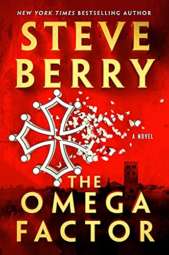 Steve Berry, master of thrillers rooted in historical speculation, is back with a humdinger of a tale in The Omega Factor (Grand Central) featuring a crackerjack plot and terrific new hero.
Steve Berry, master of thrillers rooted in historical speculation, is back with a humdinger of a tale in The Omega Factor (Grand Central) featuring a crackerjack plot and terrific new hero.
Like previous Berry protagonist Cotton Malone, Nicholas Lee has a unique portfolio that finds him serving as an operative for the United Nations’ Cultural Liaison and Investigative Office. That role sends him off on the trail of the Ghent Altarpiece, a little-known artifact that has been subject to all manner of subterfuge through history. It falls on Lee to find out why at long last, even as the Vatican opposes his efforts at every turn. At the heart of the conspiracy lies both terrible truths and startling revelations Lee must uncover against the concerted efforts of cult-like groups committed to keeping the long-kept secrets safe at all costs.
As always, Berry is in firm command of the material and maintains his equally firm hold on the sub-genre that Dan Brown created with The Da Vinci Code, and its sequels. The Omega Factor is every bit the equal of those, a textbook perfect thriller.
Amazon | Barnes & Noble | IndieBound | Bookshop
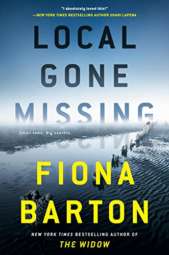 Fiona Barton takes us into the darkness at the heart of suburban, seaside America with Local Gone Missing, (Berkley), a tale that simmers for a while before ratcheting up to high heat.
Fiona Barton takes us into the darkness at the heart of suburban, seaside America with Local Gone Missing, (Berkley), a tale that simmers for a while before ratcheting up to high heat.
Detective extraordinaire Elise King happens to be on medical leave in a small, coastal town that decides to host a Woodstock-like music festival. Before you can say Max Yasgur’s farm, the locals are divided into two rival camps, those for and those against. The latter seem to be winning the day when teenage drug overdoses dominate the start of the festival. It’s the disappearance of an adult, though, that grabs Elise’s attention and rekindles her skills as a detective.
The real fun of Local Gone Missing lies in the contrast between the sprawling crowd-packed concert site and the claustrophobic consciousness of the town of Edding itself. In that sense, Barton’s latest reads like a more grounded version of Ira Levin’s The Stepford Wives, in which suburban paranoia runs amok. A sterling achievement in storytelling.
Amazon | Barnes & Noble | IndieBound | Bookshop
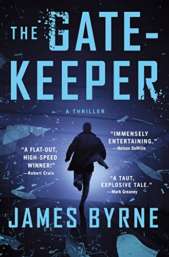 There’s nothing more satisfying, from a reading perspective, than discovering a series at the beginning instead of in the middle or nearer the end. That’s the way I felt when reading James Byrne’s The Gatekeeper (Minotaur), a superb debut and start of something truly special.
There’s nothing more satisfying, from a reading perspective, than discovering a series at the beginning instead of in the middle or nearer the end. That’s the way I felt when reading James Byrne’s The Gatekeeper (Minotaur), a superb debut and start of something truly special.
Our hero, Desmond “Dez” Limeric, is cut from a cloth comparable to the likes of Jack Reacher, Mitch Rapp, and Scott Harvath — a man with a secretive military background who did some really hard things and is about to do some that are even harder. In “The Gatekeeper” Dez just happens to be in the area when a paramilitary team targets an (apparently) innocent young woman. Suffice it to say, things do not go well for them, thanks to Dez’s intervention. And that’s just for starters, as powers that intend to bring the US to its knees never counted on a single man capable of preventing the country’s legs from being kicked out.
Like other entries in this particular thriller sub-genre, The Gatekeeper moves so fast and so well, that the action’s improbable nature never even occurs to you. You’re having too much fun to stop and think, and this series debut delivers everything a great action thriller is supposed to.
Amazon | Barnes & Noble | IndieBound | Bookshop
 Erica Ferencik’s Girl in Ice (Scout Press) is one of those rare thrillers that stays with you long after you’ve finished it, in large part because of a blisteringly original premise.
Erica Ferencik’s Girl in Ice (Scout Press) is one of those rare thrillers that stays with you long after you’ve finished it, in large part because of a blisteringly original premise.
A young girl has been found miraculously alive within an Arctic ice shelf. Master linguist Val Chesterfield happens to be in the same area, thanks to the tragic death of her twin brother to suicide (or was it?). That means finding the girl alive under the ice becomes the second mystery Val needs to solve in the Arctic, as she uses her expertise to establish a means of communication with that girl found in the ice. Secrets abound, and the truth proves an even harder, and more dangerous, find than the miracle girl herself.
As much a psychological thriller as survival tale, Girl on Ice resonates on multiple levels toward establishing a unique template that makes it a great read.
Amazon | Barnes & Noble | IndieBound | Bookshop
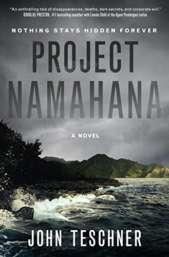 Speaking of books with a backdrop in nature, look no further than Project Namahana (Forge), John Teschner’s superb first effort.
Speaking of books with a backdrop in nature, look no further than Project Namahana (Forge), John Teschner’s superb first effort.
In stark contrast to the aforementioned Girl in Ice, the action here is staged in tropical Hawaii, mostly the island of Kua’i. That’s where a whole bunch of corporate-run farms, an economic necessity but environmental ravager, are based. And that’s where we meet Jonah, haunted by the death of his son to the midwestern moguls behind the farms that are sweeping across the once pristine land. We’ve seen what happens next before, but never the way Jonah does it in this otherwise idyllic world.
It would be easy to tag Project Namahana as “Death Wish in Hawaii,” but that wouldn’t do the book the justice it deserves. Teschner’s debut follows a man’s quest to preserve beauty in the world against the ugliness of his own tortured psyche. A brilliant treatise on the limits of man and masterful illustration of the power of storytelling.
Amazon | Barnes & Noble | IndieBound | Bookshop
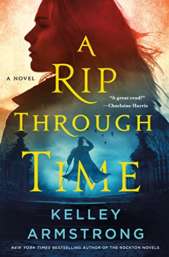 Time travel stories are a guilty pleasure of mine, so it should come as no surprise that I found Kelley Armstrong’s A Rip Through Time (Minotaur) to be a rip-roaring great read.
Time travel stories are a guilty pleasure of mine, so it should come as no surprise that I found Kelley Armstrong’s A Rip Through Time (Minotaur) to be a rip-roaring great read.
After being mugged while out jogging in her native Edinburgh, homicide detective Mallory Atkinson wakes up in the body of Catriona Mitchell on the same day in 1869. Catriona serves as a housemaid to the local undertaker, who’s got more work than he can handle thanks to a Jack the Ripper-like serial killer who’s terrorizing the city’s streets. Following the form that would make H. G. Wells himself proud, Mallory takes up the challenge of catching the culprit before he strikes again, putting all of her considerable skills to use with none of the modern forensic conveniences to rely upon.
A Rip Through Time is great fun from beginning to end, especially those scenes where we watch Mallory make do with what she’s got. By the end of the book, she’s going to wish she had her trusty nine-millimeter pistol, but her wits will have to suffice in the best time travel tale I’ve read in a long time.
Amazon | Barnes & Noble | IndieBound | Bookshop
 The fourth book in Lee Goldberg’s Hollywood-based crime series, Movieland (Thomas & Mercer), is his most ambitious and best realized yet.
The fourth book in Lee Goldberg’s Hollywood-based crime series, Movieland (Thomas & Mercer), is his most ambitious and best realized yet.
Once again the action is driven by Los Angeles County Sheriff’s Department homicide detectives Eve Ronin and Duncan Pavone. This time their quarry is a sniper who’s roiling the residents of prime California real estate by claiming victim after victim in apparently random shootings. For some reason, though, the powers at be seem bent at forestalling their efforts at every turn. That’s nothing new for Eve, only this time the target long on her back ends up in the gunman’s crosshairs.
Movieland is crime writing of the highest order. Goldberg’s style touches on both Michael Connelly and Robert Crais, company in which he now squarely belongs.
Amazon | Barnes & Noble | IndieBound | Bookshop
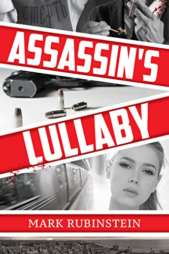 Mark Rubinstein has always written extremely well but has never cashed in his literary golden ticket until now with Assassin’s Lullaby (Thunder Lake Press), both a thriller extraordinaire and seminal character study from an author who’s also a psychiatrist specializing in criminal psychology.
Mark Rubinstein has always written extremely well but has never cashed in his literary golden ticket until now with Assassin’s Lullaby (Thunder Lake Press), both a thriller extraordinaire and seminal character study from an author who’s also a psychiatrist specializing in criminal psychology.
The book’s hero, Eli Dagan, is one of those burnt-out special operator assassins who just wants to get out of the game but has no idea how. The lifeline he’s long been after comes to him when he’s hired to help a Russian mobster facilitate his resettlement far away from the mean streets of New York City. The catch is a lot of bad people have to die first and it’s up Dagan to arrange that, blasting away to blaze his own trail into comparable obscurity.
Assassin’s Lullaby is a tale both wondrously told and elegantly conceived that’s as riveting as it is relentless.
Amazon | Barnes & Noble | IndieBound | Bookshop
RELATED POSTS
Jon Land’s Thrill List: May’s Villains Span From Fantastically Fictional to Terrifyingly True
Jon Land’s Thrill List: April Excites With Old Hollywood, Hitchcockian Technique and Historic Horror
Jon Land’s Thrill List: This March Features Harlan Coben, Lisa Scottoline and Brad Meltzer

The Omega Factor by Steve Berry
Steve Berry, master of thrillers rooted in historical speculation, is back with a humdinger of a tale in The Omega Factor (Grand Central) featuring a crackerjack plot and terrific new hero. Like previous Berry protagonist Cotton Malone, Nicholas Lee has a unique portfolio that finds him serving as an operative for the United Nations’ Cultural Liaison and Investigative Office. That role sends him off on the trail of the Ghent Altarpiece, a little-known artifact that has been subject to all manner of subterfuge through history. It falls on Lee to find out why at long last, even as the Vatican opposes his efforts at every turn. At the heart of the conspiracy lies both terrible truths and startling revelations Lee must uncover against the concerted efforts of cult-like groups committed to keeping the long-kept secrets safe at all costs. As always, Berry is in firm command of the material and maintains his equally firm hold on the sub-genre that Dan Brown created with The Da Vinci Code, and its sequels. The Omega Factor is every bit the equal of those, a textbook perfect thriller.

Local Gone Missing by Fiona Barton
Fiona Barton takes us into the darkness at the heart of suburban, seaside America with Local Gone Missing, (Berkley), a tale that simmers for a while before ratcheting up to high heat. Detective extraordinaire Elise King happens to be on medical leave in a small, coastal town that decides to host a Woodstock-like music festival. Before you can say Max Yasgur’s farm, the locals are divided into two rival camps, those for and those against. The latter seem to be winning the day when teenage drug overdoses dominate the start of the festival. It’s the disappearance of an adult, though, that grabs Elise’s attention and rekindles her skills as a detective. The real fun of Local Gone Missing lies in the contrast between the sprawling crowd-packed concert site and the claustrophobic consciousness of the town of Edding itself. In that sense, Barton’s latest reads like a more grounded version of Ira Levin’s The Stepford Wives, in which suburban paranoia runs amok. A sterling achievement in storytelling.

The Gatekeeper by James Byrne
There’s nothing more satisfying, from a reading perspective, than discovering a series at the beginning instead of in the middle or nearer the end. That’s the way I felt when reading James Byrne’s The Gatekeeper (Minotaur), a superb debut and start of something truly special. Our hero, Desmond “Dez” Limeric, is cut from a cloth comparable to the likes of Jack Reacher, Mitch Rapp, and Scott Harvath — a man with a secretive military background who did some really hard things and is about to do some that are even harder. In “The Gatekeeper” Dez just happens to be in the area when a paramilitary team targets an (apparently) innocent young woman. Suffice it to say, things do not go well for them, thanks to Dez’s intervention. And that’s just for starters, as powers that intend to bring the US to its knees never counted on a single man capable of preventing the country’s legs from being kicked out. Like other entries in this particular thriller sub-genre, The Gatekeeper moves so fast and so well, that the action’s improbable nature never even occurs to you. You’re having too much fun to stop and think, and this series debut delivers everything a great action thriller is supposed to.
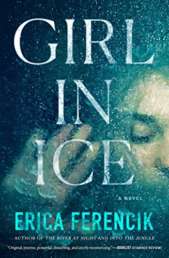
Girl in Ice by Erica Ferencik
Erica Ferencik’s Girl in Ice (Scout Press) is one of those rare thrillers that stays with you long after you’ve finished it, in large part because of a blisteringly original premise. A young girl has been found miraculously alive within an Arctic ice shelf. Master linguist Val Chesterfield happens to be in the same area, thanks to the tragic death of her twin brother to suicide (or was it?). That means finding the girl alive under the ice becomes the second mystery Val needs to solve in the Arctic, as she uses her expertise to establish a means of communication with that girl found in the ice. Secrets abound, and the truth proves an even harder, and more dangerous, find than the miracle girl herself. As much a psychological thriller as survival tale, Girl on Ice resonates on multiple levels toward establishing a unique template that makes it a great read.

Project Namahana by John Teschner
Speaking of books with a backdrop in nature, look no further than Project Namahana (Forge), John Teschner’s superb first effort. In stark contrast to the aforementioned Girl in Ice, the action here is staged in tropical Hawaii, mostly the island of Kua’i. That’s where a whole bunch of corporate-run farms, an economic necessity but environmental ravager, are based. And that’s where we meet Jonah, haunted by the death of his son to the midwestern moguls behind the farms that are sweeping across the once pristine land. We’ve seen what happens next before, but never the way Jonah does it in this otherwise idyllic world. It would be easy to tag Project Namahana as “Death Wish in Hawaii,” but that wouldn’t do the book the justice it deserves. Teschner’s debut follows a man’s quest to preserve beauty in the world against the ugliness of his own tortured psyche. A brilliant treatise on the limits of man and masterful illustration of the power of storytelling.

A Rip Through Time by Kelley Armstrong
Time travel stories are a guilty pleasure of mine, so it should come as no surprise that I found Kelley Armstrong’s A Rip Through Time (Minotaur) to be a rip-roaring great read. After being mugged while out jogging in her native Edinburgh, homicide detective Mallory Atkinson wakes up in the body of Catriona Mitchell on the same day in 1869. Catriona serves as a housemaid to the local undertaker, who’s got more work than he can handle thanks to a Jack the Ripper-like serial killer who’s terrorizing the city’s streets. Following the form that would make H. G. Wells himself proud, Mallory takes up the challenge of catching the culprit before he strikes again, putting all of her considerable skills to use with none of the modern forensic conveniences to rely upon. A Rip Through Time is great fun from beginning to end, especially those scenes where we watch Mallory make do with what she’s got. By the end of the book, she’s going to wish she had her trusty nine-millimeter pistol, but her wits will have to suffice in the best time travel tale I’ve read in a long time

Movieland by Lee Goldberg
The fourth book in Lee Goldberg’s Hollywood-based crime series, Movieland (Thomas & Mercer), is his most ambitious and best realized yet. Once again the action is driven by Los Angeles County Sheriff’s Department homicide detectives Eve Ronin and Duncan Pavone. This time their quarry is a sniper who’s roiling the residents of prime California real estate by claiming victim after victim in apparently random shootings. For some reason, though, the powers at be seem bent at forestalling their efforts at every turn. That’s nothing new for Eve, only this time the target long on her back ends up in the gunman’s crosshairs. Movieland is crime writing of the highest order. Goldberg’s style touches on both Michael Connelly and Robert Crais, company in which he now squarely belongs.

Assassin’s Lullaby by Mark Rubinstein
Mark Rubinstein has always written extremely well but has never cashed in his literary golden ticket until now with Assassin’s Lullaby (Thunder Lake Press), both a thriller extraordinaire and seminal character study from an author who’s also a psychiatrist specializing in criminal psychology. The book’s hero, Eli Dagan, is one of those burnt-out special operator assassins who just wants to get out of the game but has no idea how. The lifeline he’s long been after comes to him when he’s hired to help a Russian mobster facilitate his resettlement far away from the mean streets of New York City. The catch is a lot of bad people have to die first and it’s up Dagan to arrange that, blasting away to blaze his own trail into comparable obscurity. Assassin’s Lullaby is a tale both wondrously told and elegantly conceived that’s as riveting as it is relentless.




